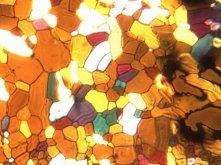
A thin (0.1 mm) layer of water that is frozen and examined under polarized light. Courtesy of Rainer Stahlberg and Gerald H. Pollack, University of Washington
Despite what you may have heard, water doesn’t always freeze at 32 degrees Fahrenheit. A team of scientists in Israel has come up with a way to control the temperature at which water will freeze.
A Matter Of Surface
Water, it turns out, is reluctant to freeze. Ice crystals prefer something to form on — a particle of dust will work, or a rough surface. The scientific team found that dust-free water on a smooth, clean surface will drop well below 32 Fahrenheit (zero Celsius) before it freezes. In this state, the water is called “supercooled.” But once one crystal does form, the supercooled water will freeze rock-solid in an instant.
Igor Lubomirsky of Israel’s Weizmann Institute of Science has been working with unusual materials called pyroelectric amorphous solids. These materials change their electrical charge depending on their temperature. Lubomirsky noticed that when he put water on these materials, the freezing point depended on the charge. Negative charge lowers the freezing point, positive charges raise it.
“Just the presence of electric charge by itself, on a surface that is not conductive, does something to water,” he says.
'A Good Subject To Think About’
Lubomirsky found something else strange. On a positively charged surface, the water freezes from the bottom up, and on a negative surface, the water freezes from the top down.
Lubomirsky says he doesn't know why changing charge alters the freezing properties of the water. “But what we do know is we have a very, very, very good subject to think about,” he says. His results appear in the latest edition of the journal Science.
Lithium tantalate was one of the materials the team studied. At minus 11 degrees Celsius, lithium tantalate is negatively charged. When the temperature rises 3 degrees, however, it becomes positively charged. And since water freezes more easily at a higher temperature on positively charged surfaces, as you warm the supercooled liquid, it becomes solid — findings not at all in line with what we know from everyday life.
Franz Geiger, a physical chemist at Northwestern University in Illinois, thinks Lubomirsky’s work may be important for climate modeling. That’s because ice crystals form on dust in the atmosphere — this is how clouds are made. Dust can have different electrical charges, and that could change the temperature at which clouds form — which in turn could affect global temperatures.
